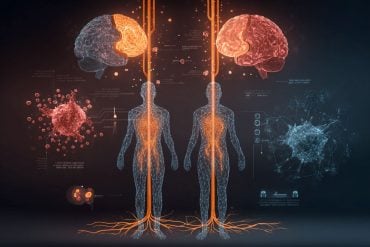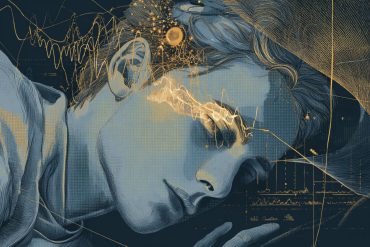Summary: Circadian rhythm disruption is a psychopathological factor shared by a broad range of mental illnesses.
Source: UC Irvine
Anxiety, autism, schizophrenia and Tourette syndrome each have their own distinguishing characteristics, but one factor bridging these and most other mental disorders is circadian rhythm disruption, according to a team of neuroscience, pharmaceutical sciences and computer science researchers at the University of California, Irvine.
In an article published recently in the Nature journal Translational Psychiatry, the scientists hypothesize that CRD is a psychopathology factor shared by a broad range of mental illnesses and that research into its molecular foundation could be key to unlocking better therapies and treatments.
“Circadian rhythms play a fundamental role in all biological systems at all scales, from molecules to populations,” said senior author Pierre Baldi, UCI Distinguished Professor of computer science. “Our analysis found that circadian rhythm disruption is a factor that broadly overlaps the entire spectrum of mental health disorders.”
Lead author Amal Alachkar, a neuroscientist and professor of teaching in UCI’s Department of Pharmaceutical Sciences, noted the challenges of testing the team’s hypothesis at the molecular level but said the researchers found ample evidence of the connection by thoroughly examining peer-reviewed literature on the most prevalent mental health disorders.
“The telltale sign of circadian rhythm disruption – a problem with sleep – was present in each disorder,” Alachkar said.
“While our focus was on widely known conditions including autism, ADHD and bipolar disorder, we argue that the CRD psychopathology factor hypothesis can be generalized to other mental health issues, such as obsessive-compulsive disorder, anorexia nervosa, bulimia nervosa, food addiction and Parkinson’s disease.”
Circadian rhythms regulate our bodies’ physiological activity and biological processes during each solar day. Synchronized to a 24-hour light/dark cycle, circadian rhythms influence when we normally need to sleep and when we’re awake.
They also manage other functions such as hormone production and release, body temperature maintenance and consolidation of memories. Effective, nondisrupted operation of this natural timekeeping system is necessary for the survival of all living organisms, according to the paper’s authors.
Circadian rhythms are intrinsically sensitive to light/dark cues, so they can be easily disrupted by light exposure at night, and the level of disruption appears to be sex-dependent and changes with age. One example is a hormonal response to CRD felt by pregnant women; both the mother and the fetus can experience clinical effects from CRD and chronic stress.
“An interesting issue that we explored is the interplay of circadian rhythms and mental disorders with sex,” said Baldi, director of UCI’s Institute for Genomics and Bioinformatics. “For instance, Tourette syndrome is present primarily in males, and Alzheimer’s disease is more common in females by a ratio of roughly two-thirds to one-third.”
Age also is an important factor, according to scientists, as CRD can affect neurodevelopment in early life in addition to leading to the onset of aging-related mental disorders among the elderly.
Baldi said an important unresolved issue centers on the causal relationship between CRD and mental health disorders: Is CRD a key player in the origin and onset of these maladies or a self-reinforcing symptom in the progression of disease?
To answer this and other questions, the UCI-led team suggests an examination of CRD at the molecular level using transcriptomic (gene expression) and metabolomic technologies in mouse models.

“This will be a high-throughput process with researchers acquiring samples from healthy and diseased subjects every few hours along the circadian cycle,” Baldi said.
“This approach can be applied with limitations in humans, since only serum samples can really be used, but it could be applied on a large scale in animal models, particularly mice, by sampling tissues from different brain areas and different organs, in addition to serum. These are extensive, painstaking experiments that could benefit from having a consortium of laboratories.”
He added that if the experiments were conducted in a systematic way with respect to age, sex and brain areas to investigate circadian molecular rhythmicity before and during disease progression, it would help the mental health research community identify potential biomarkers, causal relationships, and novel therapeutic targets and avenues.
This project involved scientists from UCI’s Department of Pharmaceutical Sciences, Center for the Neurobiology of Learning and Memory, Department of Computer Science, Department of Neurobiology and Behavior, and Institute for Genomics and Bioinformatics; as well as UCLA’s Oppenheimer Center for Neurobiology of Stress and Resilience and Goodman-Luskin Microbiome Center.
Funding: The National Institutes of Health provided financial support.
About this mental health research news
Author: Brian Bell
Source: UC Irvine
Contact: Brian Bell – UC Irvine
Image: The image is in the public domain
Original Research: Open access.
“The hidden link between circadian entropy and mental health disorders” by Pierre Baldi et al. Translational Psychiatry
Abstract
The hidden link between circadian entropy and mental health disorders
The high overlapping nature of various features across multiple mental health disorders suggests the existence of common psychopathology factor(s) (p-factors) that mediate similar phenotypic presentations across distinct but relatable disorders.
In this perspective, we argue that circadian rhythm disruption (CRD) is a common underlying p-factor that bridges across mental health disorders within their age and sex contexts.
We present and analyze evidence from the literature for the critical roles circadian rhythmicity plays in regulating mental, emotional, and behavioral functions throughout the lifespan.
A review of the literature shows that coarse CRD, such as sleep disruption, is prevalent in all mental health disorders at the level of etiological and pathophysiological mechanisms and clinical phenotypical manifestations.
Finally, we discuss the subtle interplay of CRD with sex in relation to these disorders across different stages of life.
Our perspective highlights the need to shift investigations towards molecular levels, for instance, by using spatiotemporal circadian “omic” studies in animal models to identify the complex and causal relationships between CRD and mental health disorders.







